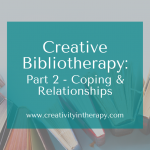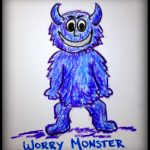
In my work with children, I often need to help clients who are struggling with sleep, especially because of fears and nightmares. Books and creativity provide helpful ways to approach these topics with kids, teaching them self-soothing skills to use at night and empowering them to respond to fears that may come up. Of course, always take the time to investigate what is going on with your client specifically so that you can address the underlying reasons for trouble sleeping – a child with anxiety or trauma who is scared to sleep because of chronic nightmares is going to have different needs that a child with ADHD who has trouble calming down and getting sleepy.
Here are some creative approaches that I have found helpful:
1. Tell the story of the nightmare or bedtime fear. Using words, play, or art to tell the story of a nightmare (or a fear) can help a child to get it out of their mind, and it can feel more contained when it is put down on the page. This distance can help kids feel a little more in control and less overwhelmed. It also provides an opportunity to safely face the images, thoughts, and emotions brought up by the dream or fear instead of just resorting to avoidance.
2. Use experiential activities to destroy, contain, or erase the nightmare or fear. I have seen kids do this in a variety of ways – put it in an envelope or box and tape it up, lock it up in the therapist filing cabinet, tear or cut it up, put it through the paper shredder, or erase it over and over from a marker board. These activities can help to release some of the fear and give a sense of power back to the child.
3. Teach kids to “rewrite” their bad dreams. Giving a bad dream a new ending can be empowering, as well as help the child to shift the emotions associated with the memory of the dream. The new ending can be silly, positive, or put the child in a position of power. Write, draw, or play out the new ending to really explore it and help it stick in the child’s mind. (Image Rehearsal Therapy or IRT is a more entailed process with the same underlying idea and is very effective for adults with chronic nightmares.) You can also take a similar approach with reimagining the thing that they are afraid of – for example, maybe the “monster” in the closet is actually silly and friendly or the weird noise outside is birds setting up for party.
4. Practice soothing the mind before bedtime with deep breathing and imagining a safe, peaceful place. In session you can practice using a guided imagery and deep breathing prompts to help a child feels relaxed, then ask them to image a safe, peaceful place to be. As part of a bedtime routine, you could even give a specific prompt to image a safe, peaceful place where they are lying down somewhere cozy and soft. After they have their imagery developed, take some time to draw, paint, or sculpt a reminder of their peaceful place. Send home guided imagery instructions with parents so that they can use the relaxation process and safe, peaceful place as part of the bedtime routine together.
5. Create a soothing or empowering object together to take home. A transitional object from therapy can lend the child encouragement at home. Get creative based on your client’s interests and needs, but some examples include customized “monster spray” or “sleep spray” made with aromatherapy oils, a small handsewn animal or pillow (add lavender or essentials oils) made in session together, handmade worry dolls, a worry box in which to put away anxious thoughts, and a special night light (e.g., a diy firefly and paper Minecraft torch are easy to add small battery lights to).
Books to support children with nightmares or bedtime anxiety:
The Dream Director, by Krysten Taprell – A story that tells about a young boy who learns to be the “director” in his dreams by taking charge and changing the endings so that they are not scary anymore.
What to Do When You Dread Your Bed, by Dawn Huebner – Part of the “What to Do When” series, this book uses CBT approaches that are playfully presented to help children (and their parents) feel in control of nighttime fears and sleep more peacefully.
The Nightmare Survival Kit – This workbook help reinforce strategies for dealing with anxiety and nightmares (e.g., who can you talk to, what can you see in your room that is comforting, addressing anxious thoughts, and rewriting your dream), as well as offering a place that they can draw and write on each page.
The Goodnight Caterpillar, by Lori Lite – This sweet story walks children through a bedtime relaxation process as they listen to a caterpillar learn to calm his mind and body for sleep.
Scaredy Squirrel at Night, by Melanie Watt – My own son has always liked the Scaredy Squirrel books, which address different worries in a playful and sometimes silly way through the stories of an anxious squirrel.
Scaredy Monster and the Bad Dream – The Scaredy Monster series on the Epic! Books app is another great series for kids to normalize anxiety and teach some ideas for how to manage the worries.
I’d love to hear your thoughts! Do you have a favorite children’s book or activity to help address fears at bedtime and bad dreams? Let me know in the comments below.
Carolyn Mehlomakulu, LMFT-S, ATR-BC is an art therapist in Austin, Texas who works with children, teens, and families. For more information about telehealth and online therapy, individual therapy, child and teen counseling, and art therapy services, please visit: www.therapywithcarolyn.com. Carolyn is also the author of The Balanced Mind – A Mental Health Journal, a guided journal that combines writing and art prompts to support your mental health.
This blog post contains affiliate links and I earn a small commission for your purchases. This blog is not intended to diagnose or treat any mental health conditions. All directives, interventions, and ideas should be used by qualified individuals within the appropriate bounds of their education, training, and scope of practice. Information presented in this blog does not replace professional training in child and family therapy, art therapy, or play therapy. Art therapy requires a trained art therapist.





Leave a Reply